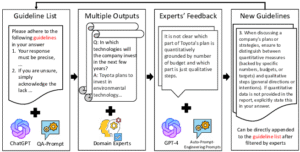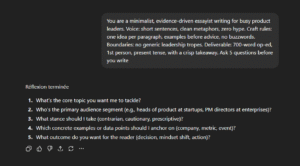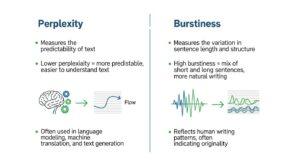Ever read a blog post and immediately thought, “This was definitely written by ChatGPT”?
AI-generated content is everywhere – and readers are becoming experts at spotting it.
In this article, you’ll learn precisely which words, expressions, metaphors, and writing structures ChatGPT repeats too often – so you stop sounding too robotic.
ChatGPT Overused Vocabulary

If you’ve been using ChatGPT to create content, you’ve likely noticed certain words keep showing up. Again and again.
Here are some of the top offenders you should watch out for:
- Comprehensive: Used in place of “detailed”, “full”, or “thorough”. ChatGPT favors this because it sounds formal and inclusive.
- Crucial, vital, pivotal: These dramatic adjectives are high-frequency tokens in AI’s training data, especially in business and academic texts.
- Explore, delve into, unpack: These verbs are often used to introduce a topic. They’re everywhere in online explainer-style articles and so become default picks.
- Harness, leverage, utilize: Used in business contexts to sound authoritative, but often overkill. “Use” would do just fine.
- Empower, enable, enhance: These sound motivational but are vague. They come from marketing-heavy sources in the AI’s training data.
- Landscape, realm, space: Used as stand-ins for “industry” or “field”. These abstract nouns are often used to pad out language.
- Unlock the potential of, tap into, maximize: These turn simple actions into metaphors. Common in promotional copy and easily picked up by ChatGPT.
Why ChatGPT Overuses Them
It all comes down to how large language models work. ChatGPT predicts the next word in a sentence based on probability. So, if a particular word tends to follow a certain phrase in its training data, it’ll suggest that – every time.
For example:
In hundreds of thousands of training examples, the phrase “In this article, we’ll…” is followed by “explore”, “delve into”, or “discuss”. So those verbs become the default.
This is called next-token prediction bias.
ChatGPT Overused Expressions

ChatGPT also loves some specific expressions way of speaking.
Here’s a breakdown of the expressions that flood ChatGPT outputs:
- “It’s important to note that…”: Used to signal emphasis, but usually adds nothing.
- “In today’s fast-paced world…”: A clichéd opener. It generalizes the context, sets a vague tone, and shows up in every second blog post.
- “A deeper understanding of…”: Often used to fake insight. The sentence usually ends up stating the obvious.
- “Unlock the power of…”: Common in promotional copy. Tries to sound inspirational, but ends up sounding like every other sales page.
- “Delve into”, “dive in”, “take a closer look”: Repetitive ways to say “let’s talk about this.” They’re used to vary tone—but ironically, they don’t.
- “Navigate the landscape of…”: Sounds thoughtful, but it’s vague and abstract. It doesn’t say what the topic actually is.
- “That said,” “On the other hand,” “At the end of the day”: Transitions that often don’t connect two real ideas. Just default glue.
- “Revolutionizing the way we…”: Used even when the change is minor. A clear sign of overused tech hype.
- “Whether you’re a beginner or an expert…”: Attempts to sound inclusive, but overused to the point of becoming meaningless.
- “Let’s face it,” “The truth is,” “You’re not alone”: Meant to create connection—but repeated so often, they feel artificial.
Why ChatGPT Leans on These
ChatGPT is trained on billions of words. A big part of that training comes from blog articles, product pages, and marketing sites. These all tend to rely on formulaic, professional-sounding phrases. Over time, the model internalizes these expressions as “safe defaults.
ChatGPT Overused Writing Structures

More generally, ChatGPT often falls into predictable writing structures. They can definitely feel mechanical, repetitive, and sound AI-generated.
Repetitive Openings and Conclusions
AI-generated content often starts and ends with formulaic phrases like:
- “In today’s fast‑paced world…”
- “One of the most important aspects…”
- “In conclusion, it is clear that…”
Instead of these, vary the hooks. Use real examples, surprising stats, or a direct question. And skip “in summary” closures—opt for a final thought that ties back to the reader.
Predictable Paragraph Patterns
Typically, ChatGPT uses the classic structure: a topic sentence, three supporting ideas, and a formal wrap-up sentence. It follows a rigid rhythm across sections.
It also love semi-colons : 3 steps structure “this, this, and also that”.
Humans often mix sentence lengths, add digressions, or shift tone. To break the pattern, mix longer and shorter sentences. Add a parenthetical, a side note, or a simple emotional insight.
Frequent Use of “Whether…or” and Contrastive Forms
ChatGPT loves correlative constructions: “whether…or”, “on the one hand…on the other hand”, “not only…but also”. They offer clear structure, but the repeated use limits variety of tone and pace.
Instead, connect ideas using natural flow: pose a rhetorical question, use a shift like “then again,” or drop the correlative structure entirely.
Rigid Transitions and Explanatory Glue
Transitions like “It is worth noting that”, “In light of this”, and “Without further ado” are ChatGPT favorites. These connectors appear in section after section, causing redundancy and flat tone.
You don’t need a formal cue every time. When you switch topics, let the content speak: “Switch gears,” “Here’s why,” or simply let the next idea stand on its own.
Overuse of Lists and Bullet Points
AI-generated content leans heavily on bullet lists. Lists are efficient, but overuse flattens the narrative. Too many can make content feel like a checklist, not a conversation.
Human writing weaves examples, analogies, and occasional asides into paragraphs. To vary structure, mix in micro-stories, reader-addressing questions, and fewer fragmented points.
Lack of Emotional or Human Touch
ChatGPT usually avoids emotion, opinion, or first-person perspectives unless explicitly prompted. Its default tone is neutral, polish-focused—almost robotic.
Add your voice. Use “I’ve seen,” “you might notice,” or “here’s a trade-off” to break the monotony. A human voice changes tone, style, and pacing across sections.






